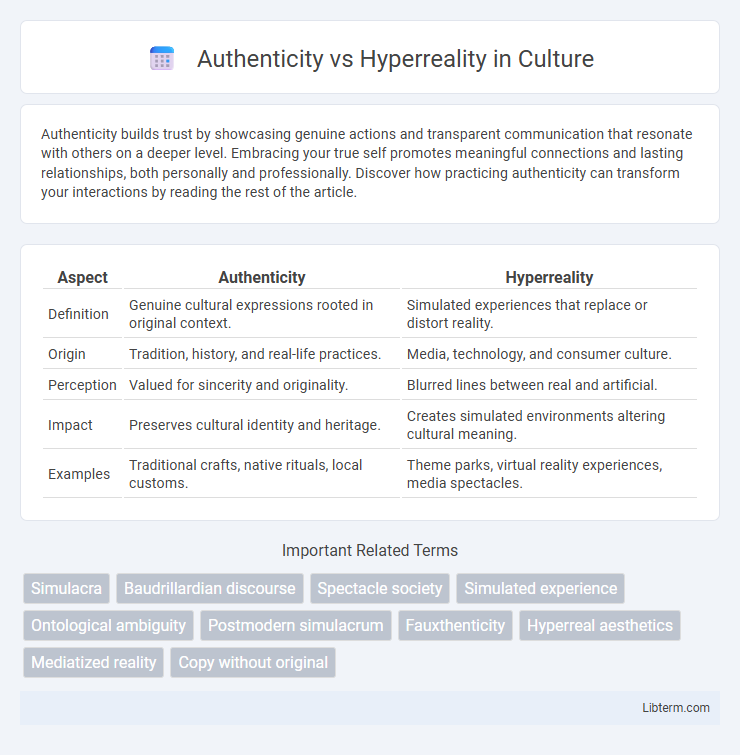Authenticity builds trust by showcasing genuine actions and transparent communication that resonate with others on a deeper level. Embracing your true self promotes meaningful connections and lasting relationships, both personally and professionally. Discover how practicing authenticity can transform your interactions by reading the rest of the article.
Table of Comparison
| Aspect | Authenticity | Hyperreality |
|---|---|---|
| Definition | Genuine cultural expressions rooted in original context. | Simulated experiences that replace or distort reality. |
| Origin | Tradition, history, and real-life practices. | Media, technology, and consumer culture. |
| Perception | Valued for sincerity and originality. | Blurred lines between real and artificial. |
| Impact | Preserves cultural identity and heritage. | Creates simulated environments altering cultural meaning. |
| Examples | Traditional crafts, native rituals, local customs. | Theme parks, virtual reality experiences, media spectacles. |
Understanding Authenticity in the Digital Age
Authenticity in the digital age involves discerning genuine experiences and identities from constructed or simulated ones, often blurred by social media and virtual realities. The concept of hyperreality, where representations replace or distort reality, challenges traditional notions of authenticity by creating environments that feel real but are entirely fabricated. Understanding authenticity requires critical evaluation of digital content and self-presentation to maintain a connection to true personal and cultural values amid pervasive digital manipulation.
Defining Hyperreality: Beyond the Real
Hyperreality refers to a condition in which the distinction between reality and simulated representations blurs, resulting in experiences that seem more real than actual reality. This concept, introduced by philosopher Jean Baudrillard, describes how media, technology, and consumer culture create hyperreal environments where signs and images replace direct experience. Hyperreality challenges the notion of authenticity by presenting fabricated versions of reality that are accepted as genuine, thus reshaping perceptions and social interactions.
The Roots of Authentic Experience
The roots of authentic experience lie in genuine human interaction and the unmediated perception of reality, where individuals engage with their environment and emotions directly. Authenticity emerges from the alignment of personal values, cultural context, and lived experience, contrasting sharply with hyperreality, which simulates and distorts these elements through media and technology. Philosophers like Jean Baudrillard argue that hyperreality manufactures a reality that replaces the real, making authentic experiences increasingly elusive in contemporary society.
Hyperreality in Media and Technology
Hyperreality in media and technology blurs the line between reality and simulation by creating experiences that feel more real than actual life, driven by virtual reality, augmented reality, and highly curated social media content. The saturation of digital images and interactive platforms generates a constructed reality where symbols and signs replace genuine human experiences, intensifying the perception of a hyperreal world. This phenomenon challenges traditional notions of authenticity as users increasingly engage with mediated representations rather than unfiltered reality.
Social Media: Curated Lives vs Genuine Selves
Social media platforms amplify hyperreality by encouraging users to present curated versions of their lives, often prioritizing aesthetic perfection over genuine experiences. This digital curation distorts authenticity, as individuals showcase idealized moments that may not reflect their true selves. The tension between projected images and authentic identity fosters a landscape where perceived reality overshadows personal truth.
The Psychology of Perceived Realness
The psychology of perceived realness explores how individuals distinguish authentic experiences from hyperreal simulations, where signs and representations replace original reality. Hyperreality, as theorized by Jean Baudrillard, creates a landscape where simulations are accepted as more real than reality itself, influencing perception, memory, and identity. This phenomenon affects cognitive processing by blurring boundaries between truth and fabrication, leading to altered emotional responses and decision-making patterns.
Authenticity in Art and Pop Culture
Authenticity in art and pop culture emphasizes genuine creative expression, rooted in original identity and cultural context, which contrasts sharply with the superficial imitation seen in hyperreality. Artists and creators who maintain authenticity foster deeper emotional connections and cultural significance, preserving historical and social truths through their work. This commitment to authenticity challenges mass-produced, simulated experiences by highlighting the value of unique, lived experiences and craftsmanship.
Navigating Truth in Hyperreal Environments
Navigating truth in hyperreal environments requires discerning authentic experiences from simulated representations crafted by media and technology. Hyperreality blurs the line between reality and simulation, challenging individuals to critically evaluate sources and context to maintain genuine understanding. Emphasizing media literacy and critical thinking is essential for recognizing manipulated narratives and preserving authenticity in a digitally saturated world.
The Impact on Identity and Relationships
The tension between authenticity and hyperreality profoundly shapes identity and relationships by blurring the boundaries between genuine experiences and constructed simulations. Hyperreality, fueled by media and digital technologies, often leads individuals to curate idealized selves, challenging the formation of authentic identities and fostering superficial connections. This persistent mediation of reality influences interpersonal dynamics, reducing trust and emotional intimacy as interactions become performances shaped by external expectations rather than sincere engagement.
Striving for Authenticity Amid Hyperreality
Striving for authenticity amid hyperreality involves discerning genuine experiences from manufactured simulations prevalent in media and consumer culture. Individuals seek meaningful connections and self-expression by rejecting superficial representations crafted through digital manipulations and mass advertising. This pursuit fosters deeper engagement with reality, emphasizing personal truth over artificial constructs.
Authenticity Infographic

 libterm.com
libterm.com